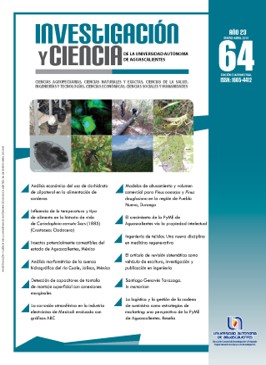Influencia de la temperatura y tipo de alimento en la historia de vida de Ceriodaphnia cornuta Sars (1885) (Crustacea: Cladocera)
DOI:
https://doi.org/10.33064/iycuaa2015643590Palabras clave:
cladócero, planctónico, tabla de vida, microalgas, temperatura, valor reproductivoResumen
Los cladóceros son pieza clave en la red trófica, ya que contribuyen a la nutrición de especies acuícolas. Se determinó mediante tablas de vida el efecto de la temperatura (20, 25 y 30 °C) y tipo de alimento (Nannochloris oculata, Scenedesmus obliquus
y Selenastrum capricornutum) en Ceriodaphnia cornuta. Resultados muestran la mayor longevidad y esperanza de vida a 20 ºC sin importar el tipo de alimento. La tasa neta de reproducción es mayor a 25 ºC y 30 ºC, con S. obliquus y/o S. capricornutum.
Según el valor reproductivo, la mayor tasa de fertilidad y fecundidad ocurre con S. obliquus. Los valores menores se registraron con N. oculata. La temperatura influye en mayor proporción que el alimento en la longevidad, fecundidad y fertilidad.
Descargas
Citas
• AMARASINGHE, P. et al. The effect of temperature, and food quantity and quality on the growth and development rates in laboratory-cultured copepods and cladocerans from Sri Lankan reservoir. Hydrobiologia, 350: 131-144, 1997.
• BEGON, M. et al. Ecology: Individuals, Populations, and Communities. 3 ed., Blackwell Scientific. 1068 pp., 1996.
• CHOUERI, R. B. et al. Effects of cyanobacterium exopolysaccharides on life-history of Ceriodaphnia cornuta SARs. Journal of Plankton Research, 29(4): 339-345, 2007.
• DEHUI, Z. Growth, reproduction and population growth of Ceriodaphnia cornuta Sars and comparison of 7-day fecundity with Ceriodaphnia dubia Richard. Chinese Journal of Oceanology and Limnology, 7(2): 105-111, 1989.
• DODSON, S. I. y HANAZATO, T. Commentary on Effects of Anthropogenic and Natural Organic Chemicals on Development, Swimming Behavior, and Reproduction of Daphnia, a Key Member of Aquatic Ecosystems. Environmental Health Perspectives, 103(4), 1995.
• ELÍAS GUTIÉRREZ, M. et al. Cladocera y Copepoda de las aguas continentales de México. Guía ilustrada. México: UNAM, pp. 322, 2008.
• FERRÃO FILHO, A. S. et al. Effects of essential fatty acids and N and P-limited algae on the growth rate of tropical cladocerans. Freshwater Biology, 48: 759-767, 2003.
• KUMAR, R. y HWANG, J. S. Ontogenic shifts in the ability of the cladoceran, Moina macrocopa Straus and Ceriodaphnia cornuta Sars to utilize ciliated protists as food source. International Review of Hydrobiologia, 93(3): 284-296, 2008.
• MARTÍNEZ JERÓNIMO, F. y VENTURA LÓPEZ, C. Population dynamics of the tropical cladoceran Ceriodaphnia rigaudi Richard, 1894 (Crustacea: Anomopoda). Effect of food type and temperature. Journal of Environmental Biology, 32: 513-521, 2011.
• NANDINI, S. y SARMA, S. S. S. Lifetable demography of four cladoceran species in relation to algal food (Chlorella vulgaris) density. Hydrobiologia, 435: 117-126, 2000.
• NANDINI, S. y SARMA, S. S. S. Population growth of some genera of cladocerans in relation to algal food (Chlorella vulgaris) levels. Hydrobiologia, 491: 211-219, 2003.
• NICHOLS, H. W. Growth media-freshwater. En J. R. Stein (Ed.), Handbook of Phycological Methods. Cambridge University Press, pp. 7-24, 1973.
• PORTILLA OCHOA, E. Ficha Informativa de los Humedales de Ramsar (FIR), 2003.
• PRIETO, M. Aspectos reproductivos del cladócero Moinodaphnia sp. en condiciones de laboratorio. Revista MVZ Córdoba, 6(002): 102-110, 2001.
• SAVAŞ, S. y ERDOĞAN, Ö. The Effect of Food (Scenedesmus acuminatus (von Lagerheim) R. H. Chodat) Densities and Temperature on the Population Growth of the Cladoceran Ceriodaphnia quadrangula (O. F. Muller, 1785). Journal of Fisheries & Aquatic Sciences, (1-2): 113-116, 2006.
• TORRENTERA, L. y TACON, A. G. J. Cultivo de microcrustáceos de agua dulce. En La producción de alimento vivo y su importancia en la acuacultura. Programa Cooperativo Gubernamental FAO-Italia, 1989.
• US ENVIRONMENTAL PROTECTION AGENCY. Methods for Measuring the Acute Toxicity of Effluents to Freshwater and Marine Organisms. EPA-600/4-85-013. Washington, DC: US Environmental Protection Agency, p. 159, 1985.
• VIEIRA, A. C. B. et al. Population dynamics of Moina minuta Hansen (1899), Ceriodaphnia cornuta Sars (1886), and Diaphanosoma spinulosum Herbst (1967) (Crustacea: Branchiopoda) in different nutrients (N and P) concentration ranges. Acta Limnologica Brasiliensia, 23(1): 48-56, 2011.
• VILLALOBOS, M. J. y GONZÁLEZ, E. J. Estudios sobre la biología y ecología de Ceriodaphnia cornuta Sars: Una revisión. Interciencia, 31(5): 351-357, 2005.
Descargas
Publicado
Cómo citar
Licencia
Derechos de autor 2015 Ignacio Alejandro Pérez Legaspi, Adriana Marisol García Villar, Mariana Garatachia Vargas, Martha Patricia Hernández Vergara, Carlos Iván Pérez Rostro, Luis Alfredo Ortega Clemente

Esta obra está bajo una licencia internacional Creative Commons Atribución-NoComercial-CompartirIgual 4.0.
Las obras publicadas en versión electrónica de la revista están bajo la licencia Creative Commons Atribución-NoComercial-CompartirIgual 4.0 Internacional (CC BY-NC-SA 4.0)









